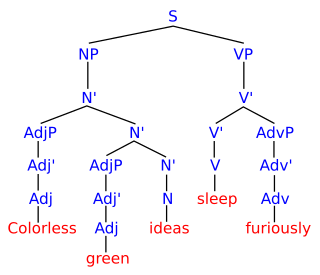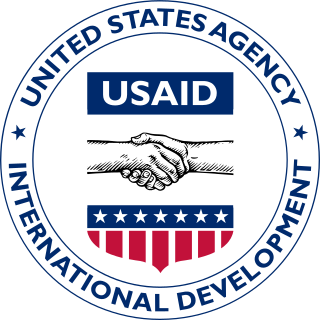
In logic, mathematics, computer science, and linguistics, a formal language consists of words whose letters are taken from an alphabet and are well-formed according to a specific set of rules called a formal grammar.

The Social Security Act of 1935 is a law enacted by the 74th United States Congress and signed into law by U.S. President Franklin D. Roosevelt on August 14, 1935. The law created the Social Security program as well as insurance against unemployment. The law was part of Roosevelt's New Deal domestic program.

The United States Agency for International Development (USAID) is an independent agency of the United States government that is primarily responsible for administering civilian foreign aid and development assistance. With a budget of over $50 billion, USAID is one of the largest official aid agencies in the world and accounts for more than half of all U.S. foreign assistance—the highest in the world in absolute dollar terms.
In the United States, federal grants are economic aid issued by the United States government out of the general federal revenue. A federal grant is an award of financial assistance from a federal agency to a recipient to carry out a public purpose of support or stimulation authorized by a law of the United States.
A block grant is a grant-in-aid of a specified amount from a larger government to a smaller regional government body. Block grants have less oversight from the larger government and provide flexibility to each subsidiary government body in terms of designing and implementing programs. Block grants, categorical grants, and general revenue sharing are three types of federal government grants-in-aid programs.
Equalization payments are cash payments made in some federal systems of government from the federal government to subnational governments with the objective of offsetting differences in available revenue or in the cost of providing services. Many federations use fiscal equalisation to reduce the inequalities in the fiscal capacities of sub-national governments arising from the differences in their geography, demography, natural endowments and economies. The level of equalisation sought can vary, however.
The Workforce Investment Act of 1998 was a United States federal law that was repealed and replaced by the 2014 Workforce Innovation and Opportunity Act.

The Elementary and Secondary Education Act (ESEA) was passed by the 89th United States Congress and signed into law by President Lyndon B. Johnson on April 11, 1965. Part of Johnson's "War on Poverty", the act has been one of the most far-reaching laws affecting education passed by the United States Congress, and was reauthorized by the No Child Left Behind Act of 2001.

In international relations, aid is – from the perspective of governments – a voluntary transfer of resources from one country to another. The type of aid given may be classified according to various factors, including its intended purpose, the terms or conditions under which it is given, its source, and its level of urgency. For example, aid may be classified based on urgency into emergency aid and development aid.

Temporary Assistance for Needy Families is a federal assistance program of the United States. It began on July 1, 1997, and succeeded the Aid to Families with Dependent Children (AFDC) program, providing cash assistance to indigent American families through the United States Department of Health and Human Services. TANF is often regarded as just "welfare", but some argue this is a misnomer. Unlike AFDC, which provided a guaranteed cash benefit to eligible families, TANF is a block grant to states that creates no federal entitlement to welfare and is used by states to provide non-welfare services, including educational services, to employed people.

The Special Supplemental Nutrition Program for Women, Infants, and Children (WIC) is an American federal assistance program of the Food and Nutrition Service (FNS) of the United States Department of Agriculture (USDA) for healthcare and nutrition of low-income pregnant women, breastfeeding women, and children under the age of five as part of child nutrition programs. Their mission is to be a partner with other services that are key to childhood and family well-being. WIC serves 53% of all infants born in the United States.
A Pell Grant is a subsidy the U.S. federal government provides for students who need it to pay for college. Federal Pell Grants are limited to students with exceptional financial need, who have not earned their first bachelor's degree, or who are enrolled in certain post-baccalaureate programs, through participating institutions. Originally known as a Basic Educational Opportunity Grant, it was renamed in 1980 in honor of Democratic U.S. Senator Claiborne Pell of Rhode Island. A Pell Grant is generally considered the foundation of a student's financial aid package, to which other forms of aid are added. The Federal Pell Grant program is administered by the United States Department of Education, which determines the student's financial need and through it, the student's Pell eligibility. The U.S. Department of Education uses a standard formula to evaluate financial information reported on the Free Application for Federal Student Aid (FAFSA) for determining the student's Expected Family Contribution (EFC).
Categorical grants, also called conditional grants, are grants issued by the United States Congress which may be spent only for narrowly defined purposes. They are the main source of federal aid to state and local governments and can be used only for specified categories of state and local spending, such as education or roads. These grants have been accompanying rules and guidelines that constrain the recipient government in the use of grant funds. Categorical grants are intended to help states improve the overall well-being of their residents, but also empower the federal government to exert more power over the states within a specific policy area.
The Community Services Block Grant (CSBG) provides federal funding for Community Action Agencies (CAAs) and other programs that seek to address poverty at the community level. Like other block grants, CSBG funds are allocated to the states and other jurisdictions through a formula, with less federal oversight and fewer federal requirements than categorical grants. The CSBG formula determines each jurisdiction's funding level based on poverty population; once disbursed, most of the money is passed by the states and other jurisdictions to CAAs and other designated organizations to be spent on employment, education, income management, housing, nutrition, emergency services, and health.
In the United States, federal assistance, also known as federal aid, federal benefits, or federal funds, is defined as any federal program, project, service, or activity provided by the federal government that directly assists domestic governments, organizations, or individuals in the areas of education, health, public safety, public welfare, and public works, among others.
In the United States, compliance requirements are a series of directives United States federal government agencies established that summarize hundreds of federal laws and regulations applicable to federal assistance. They are currently incorporated into the OMB A-133 Compliance Supplement, which was created by the US Office of Management and Budget (OMB).

In the United States, the federal and state social programs including cash assistance, health insurance, food assistance, housing subsidies, energy and utilities subsidies, and education and childcare assistance. Similar benefits are sometimes provided by the private sector either through policy mandates or on a voluntary basis. Employer-sponsored health insurance is an example of this.

A patent application or patent may contain drawings, also called patent drawings, illustrating the invention, some of its embodiments, or the prior art. The drawings may be required by the law to be in a particular form, and the requirements may vary depending on the jurisdiction.

United States foreign aid, also known as US foreign assistance consists of a variety of tangible and intangible forms of assistance the United States gives to other countries. Foreign aid is used to support American national security and commercial interests and can also be distributed for humanitarian reasons. Aid is financed from US taxpayers and other revenue sources that Congress appropriates annually through the United States budget process. It is dispersed through "over 20 U.S. government agencies that manage foreign assistance programs," although about half of all economic assistance is channeled through the United States Agency for International Development (USAID).
Welfare culture refers to the behavioral consequences of providing poverty relief to low-income individuals. Welfare is considered a type of social protection, which may come in the form of remittances, such as 'welfare checks', or subsidized services, such as free/reduced healthcare, affordable housing, and more. Pierson (2006) has acknowledged that, like poverty, welfare creates behavioral ramifications, and that studies differ regarding whether welfare empowers individuals or breeds dependence on government aid. Pierson also acknowledges that the evidence of the behavioral effects of welfare varies across countries, because different countries implement different systems of welfare.








